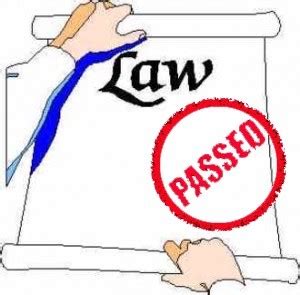Crime Control Act of 1970
“AN ACT
Relating to the control of organized crime in the United States.
Organized Crime ]enacted by the Senate and House of Representatives of the
United States of America in Congress assembled^ That this Act
may be cited as the “Organized Crime Control Act of 1970.”
STAITIMENT OF FINDINGS AND PURPOSE
The (Congress finds that (1) organized crime in the United States
is a highly sophisticated, diversified, and widespread activity that
annually drains billions of dollars from America’s economy by unlawful conduct and the illegal use of force, fraud, and corruption;
(2)
organized crime derives a major portion of its power through money
84 STAT. ] PUBLIC LAW 91-452-OCT. 15, 1970 923
obtained from such illegal endeavors as syndicated gambling, loan
sharking, the theft and fencing of property, the importation and
distribution of narcotics and other dangerous drugs, and other forms
of social exploitation; (3) this money and power are increasingly
used to infiltrate and corrupt legitimate business and labor unions
and to subvert and corrupt our democratic processes; (4) organized
crime activities in the United States weaken the stability of the
Nation’s economic system, harm innocent investors and competing
organizations, interfere with free competition, seriously burden interstate and foreign commerce, threaten the domestic security, and undermine the general welfare of the Nation and its citizens; and (5)
organized crime continues to grow because of defects in the evidence gathering process of the law inhibiting the development of the legally
admissible evidence necessary to bring criminal and other sanctions
or remedies to bear on the unlawful activities of those engaged in
organized crime and because the sanctions and remedies available to
the Government are unnecessarily limited in scope and impact.
It is the purpose of this Act to seek the eradication of organized
crime in the United States by strengthening the legal to0ls in the evidence-gathering process, by establishing new penal prohibitions, and
by providing enhanced sanctions and new remedies to deal with the
unlawful activities of those engaged in organized crime.
TITLE I—SPECIAL GRAND JUR Y
SEC. 101. (a) Title 18, United States Code, is amended by adding
immediately after chapter 215 the following new chapter: ^^ ^^^’ ^^^”^
“Chapter 216.—SPECIAL GRAND JURY
“Sec.
“3331. Summoning and term.
“3332. Powers and duties.
“3333. Reports.
“3334. General provisions.
Ҥ 3331. Summoning and term
“(a) In addition to such other grand juries as shall be called from
time to time, each district court which is located in a judicial district
containing more than four million inhabitants or in which the Attorney General, the Deputy Attorney General, or any designated Assistant Attorney General, certifies in writing to the chief judge of the
district that in his judgment a special grand jury is necessary because
of criminal activity in the district shall order a special grand jury to
be summoned at least once in each period of eighteen months unless
another special grand jury is then serving. The grand jury shall serve
for a term of eighteen months unless an order for its discharge is
924 PUBLIC LAW 91-452-OCT. 15, 1970 [84 STAT.
entered earlier by the court upon a determination of the grand jury by
majority vote that its business has been completed. If, at the end of
such term or any extension thereof, the district court determines the
business of the grand jury has not been completed, the court may enter
an order extending such term for an additional period of six months.
No special grand jury term so extended shall exceed thirty-six months,
except as provided in subsection (e) of section 3333 of this chapter.
“(b) If a district court within any judicial circuit fails to extend the
term of a special grand jury or enters an order for the discharge of
such grand jury before such grand jury determines that it has completed its business, the grand jury, upon the affirmative vote of a
majority of its members, may apply to the chief judge of the circuit
for an order for the continuance of the term of the grand jury. Upon
the making of such an application by the grand jury, the term thereof
shall continue until the entry upon such application by the chief judge
of the circuit of an appropriate order. No special grand jury term so
extended shall exceed thirty-six months, except as provided in subsection (e) of section 3333 of this chapter.
Ҥ 3332. Powers and duties
“(a ) It shall be the duty of each such grand jury impaneled within
any judicial district to inquire into offenses against the criminal laws
of the United States alleged to have been committed within that district. Such alleged offenses may be brought to the attention of the
grand jury by the court or by any attorney appearing on behalf of the
United States for the presentation of evidence. Any such attorney
receiving information concerning such an alleged offense from any
other person shall, if requested by such other person, inform the grand
jury of such alleged offense, the identity of such other person, and such
attorney’s action or recommendation.
“(b) Whenever the district court deteimines that the volume of
business of the special grand jury exceeds the capacity of the grand
jury to discharge its obligations, the district court may order an additional special grand jury for that district to be impaneled.
Ҥ 3333. Reports
“(a) A special grand jury impaneled by any district court, with
the concurrence of a majority of its members, may, upon completion
of its original term, or each extension thereof, submit to the court a
report—
“(1) concerning noncriminal misconduct, malfeasance, or misfeasance in office involving organized criminal activity by an
appointed public officer or employee as the basis for a recommendation of removal or disciplinary action; or
“(2) regarding organized crime conditions in the district.
fiUn^’^i^^Lbiic “(‘-*^ ^^ court to which such report is submitted shall examine it
recordd the minutes of the special grand jury and, except as otherwise
provided in subsections (c) and (d) of this section, shall make an order
accepting and filing such report as a public record only if the court
is satisfied that it complies w^ith the provisions of subsection (a) of
this section and that—
“(1) the report is based upon facts revealed in the course of
an investigation authorized by subsection (a) of section 3332 and
is supported by the preponderance of the evidence; and
“(2) when the report is submitted pursuant to paragraph (1)
of subsection (a) of this section, each person named therein and
any reasonable number of witnesses in his behalf as designated
by him to the foreman of the grand jury were afforded an opportu-
84 STAT. ] PUBLIC LAW 91-452-OCT. 15, 1970 925
nity to testify before the grand jury prior to the filing of such
report, and when the report is submitted pursuant to paragraph
(2) of subsection (a) of this section, it is not critical of an identified person.
“(c) (1) An order accepting a report pursuant to paragraph (1) of to^ UMIC o’ffi’J.-rs
subsection (a) of this section and the report shall be sealed by the court
and shall not be filed as a public record or be subject to subpena or
otherwise made public (i) until at least thirty-one days after a copy
of the order and report are served upon each public officer or employee
named therein and an answer has been filed or the time for filing an
answer has expired, or (ii) if an appeal is taken, until all rights of
review of the public officer or employee named therein have expired
or terminated in an order accepting the report. No order accepting a
report pursuant to paragraph (1) of subsection (a) of this section shall
be entered until thirty days after the delivery of such report to the
public officer or body pursuant to paragraph (3) of subsection (c) of
this section. The court may issue such orders as it shall deem appropriate to prevent unauthorized publication of a report. Unauthorized
publication may be punished as contempt of the court.
” (2) Such public officer or employee may file with the clerk a verified Answer, filing,
answer to such a report not later than twenty days after service of
the order and report upon him. Upon a showing of good cause, the
court may grant such public officer or employee an extension of time
within which to file such answer and may authorize such limited
publication of the report as may be necessary to prepare such answer.
Such an answer shall plainly and concisely state the facts and law constituting the defense of the public officer or employee to the charges
in said report, and, except for those parts thereof w^hich the court
determines to have been inserted scandalously, pre judiciously, or
unnecessarily, such answer shall become an appendix to the report.
“(3) Upon the expiration of the time set forth in paragraph (1) of
subsection (c) of this section, the United States attorney shall deliver
a true copy of such report, and the appendix, if any, for appropriate
action to each public officer or body having jurisdiction, responsibility,
or authority over each public officer or employee named in the report.
“(d) Upon the submission of a report pursuant to subsection (a)
ox this section, if the court finds that the filing of such report as a
public record may prejudice fair consideration of a pending criminal
matter, it shall order such report sealed and such report shall not be
subject to subpena or public inspection during the pendency of such
criminal matter, except upon order of the court”


